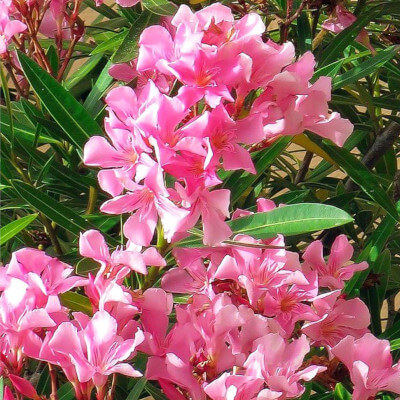
Nerium oleander, commonly known as the oleander, is a signature plant of the Au Bois Vert botanical garden. Native to Mediterranean and subtropical regions, this species belongs to the Apocynaceae family. Oleander is easily recognised by its vibrant blossoms and evergreen foliage. Its flowers, which may be single or double, range in colour from white and pink to red and yellow. Blooming in terminal clusters, they emit a delicate fragrance that draws a variety of pollinators.
This shrub can grow anywhere between 2 and 6 metres tall, depending on the growing conditions. Its leaves are long, narrow, and arranged in pairs or whorls of three. They are leathery in texture and deep green in colour, creating a striking contrast with the bright flowers. Nerium oleander is drought-tolerant and can thrive in poor soils, though it performs best in well-drained soil and full sunlight.
Thanks to its ornamental appeal, the plant is widely cultivated in gardens and parks. Particularly popular in Mediterranean climates, oleander is also found in other warm temperate regions. At the Au Bois Vert botanical garden—located near the Au Bois Vert hotel and restaurant in Ivato, Antananarivo—the oleander adds a touch of exotic charm and vivid colour to the landscape, providing visitors with a truly unique visual experience.
Plant use
The Nerium oleander, commonly known as the oleander, has several noteworthy uses despite its toxicity. All parts of the plant contain toxic compounds, particularly oleandrin, which can be harmful if ingested. However, its poisonous nature has not prevented it from being employed in various fields. Traditionally, oleander is grown as an ornamental plant in gardens and parks. Its resilience to drought and pollution makes it an excellent choice for hedges and borders. Moreover, its abundant and long-lasting flowering – from spring through to autumn – makes it a highly decorative plant. In traditional medicine, although its use carries significant risk, some cultures have turned to oleander extracts to treat a range of ailments. For instance, leaf poultices are sometimes applied to wounds and inflammations. Nonetheless, such practices should be approached with caution due to the plant’s toxic properties. At the botanical garden of Au Bois Vert, the oleander plays a key aesthetic role. Its presence adds to the rich variety of flora on display and provides visitors with a vibrant visual experience. Guests at the Au Bois Vert hotel and restaurant can admire the plant’s beauty while enjoying the peaceful surroundings of the lodge. In addition, the oleander enhances the serene and welcoming atmosphere of the botanical garden, helping to make every visit a memorable one.
Key information
| Common name | Oleander |
| Scientific name | Nerium oleander |
| Origin | Mediterranean basin, Asia |
| Natural habitat | Dry, sunny areas |
| Life cycle | Perennial, evergreen |
| Flowering period | Spring to autumn |


